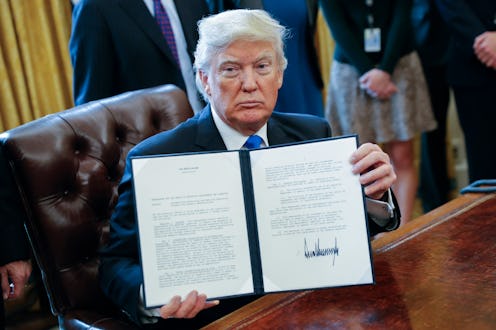News
How Exec Orders Let A President Bypass Congress

During his first week in office, President Donald Trump has made use of the presidential power to sign executive orders to quickly fulfill some of the promises he made during his campaign. Some of the orders he's signed so far include a directive for a wall to be built between the United States and Mexico, a move forward with the Keystone XL and Dakota Access Pipeline, as well as a ban on U.S. aide from being sent to foreign organizations that perform or promote abortion. With so many different actions taken so quickly, you may want to know how executive orders work.
Executive orders essentially allow the president to write policies into federal law. However, the policies do not have to go through Congress. What Congress can do is oppose an order by passing a law that overrides it. Or, they can take an indirect approach via legislation to deny funding for a specific executive order. Unfortunately, those attempts might be in vain if the president vetoes the legislation.
According to Mic, the Constitution doesn't directly address executive orders. Rather, it gives the president executive power. Somewhat troublesome, the Congressional Research Center reveals that there is no definition of executive orders. Article II of the Constitution lays out the responsibilities of the president, which includes insuring that laws are carried out.
However, just because a president signs an executive order, doesn't mean it's necessarily going to happen. For example, with Trump's executive order regarding the wall along the United States' southern border, it requires the secretary of homeland security to allocate federal funds for the project. So, of the federal money Congress has set aside in the budget, it needs to be able to be able to be interpreted as for the purpose of building a wall, which according to The Intercept, could be cost $20 billion to $40 billion. If that money isn't gathered, then the wall cannot be built or they will have to find another way to go about it.
As for the staying power of executive orders, they're pretty permanent — at least during the president's term. According to CNBC, only two executive orders have not been upheld by the Supreme Court when legally challenged. Various presidents, including Trump, have used their power to overturn previous executive orders, especially when a new political party takes control of the executive branch.
It's not abnormal for presidents throughout history to take advantage of executive orders. Former President Barack Obama signed 277 orders in his eight-year presidency, which was relatively few, especially compared to President Franklin Roosevelt's record-breaking 3,728 orders.
We can expect to see Trump issue many more executive orders throughout his presidency, but will have to wait to see if any of them will be challenged by Congress or the Supreme Court.